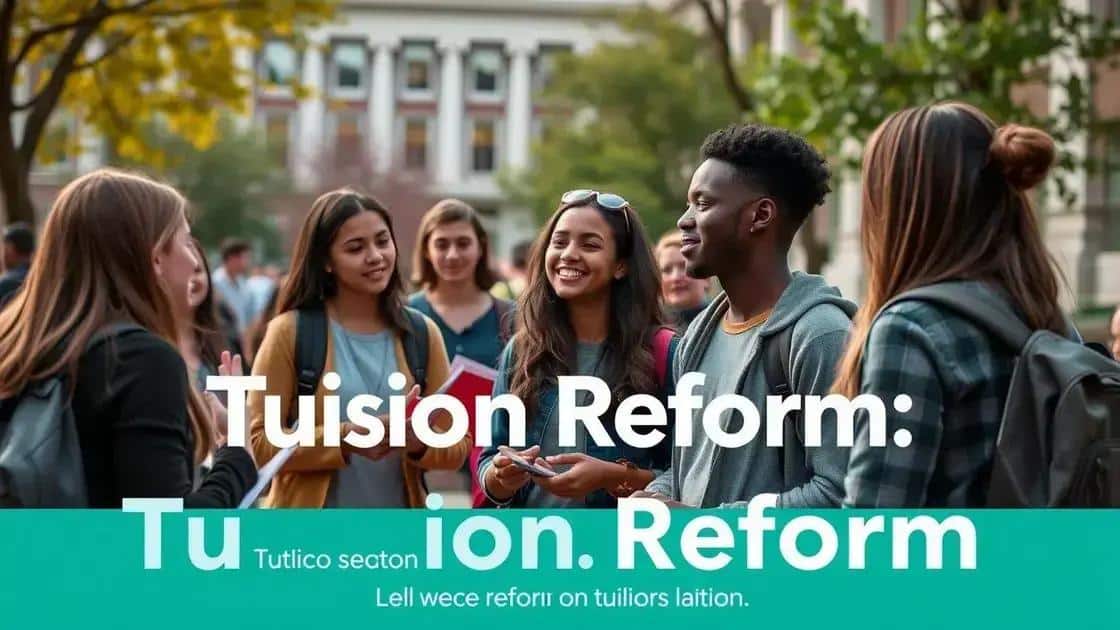Value college tuition reform: a pressing need for change

Value college tuition reform focuses on reducing rising education costs through strategies like tuition freezes, alternative funding models, and increasing online learning options to enhance affordability and accessibility for all students.
Value college tuition reform is becoming increasingly critical as students face soaring education costs. Have you ever wondered how this affects your education and future? Let’s dive into the issue and explore possible solutions.
Understanding the current college tuition crisis
The current college tuition crisis is a critical issue affecting students across the nation. As tuition rates continue to rise, many families struggle to afford a college education. Let’s take a closer look at the underlying causes of this crisis and its impact on students.
Factors Contributing to Rising Tuition
Several significant factors drive the increase in college tuition. Understanding these can help us grasp the urgency of reform.
- Reduction in state funding for public colleges.
- Increased administrative costs within universities.
- Higher demand for student services and facilities.
- Greater reliance on student loans to fund education.
Moreover, as tuition rises, many students are turning to loans, leading to debt accumulation. This situation creates a cycle where future graduates find themselves burdened with debt, which can affect their life choices and career paths. Can we imagine a world where quality education is accessible to all without the fear of crippling debt?
Impact on Students and Families
The struggles of families to afford tuition can have long-lasting effects. When tuition increases, many students either delay their education or choose less expensive institutions. Some even forgo college entirely.
This lack of accessibility can perpetuate economic inequality, as students from low-income families may find themselves unable to pursue higher education, missing out on opportunities for better jobs and careers.
It’s important to recognize the long-term implications of the tuition crisis. Educated individuals usually contribute positively to the economy, but when they carry debt, their contributions can be limited. Efforts to reform college tuition will not only aid students today but will also have benefits for our society in the future.
Key factors driving tuition increases
Understanding the key factors driving tuition increases is essential for grasping the college tuition crisis. Various elements contribute to the rising costs that families face, making education less accessible.
Funding Cuts and Budget Constraints
One major reason tuition has surged is the decrease in state funding for public universities. As government allocations shrink, schools often raise tuition to cover their operational costs. This lack of support can lead institutions to seek alternative funding sources, directly impacting students.
- Reduced financial aid options available to students.
- Increased reliance on tuition revenue for budgets.
- Challenges in maintaining academic programs.
Simultaneously, administrative costs at colleges continue to rise. Colleges are expanding their administrative staff to support various programs and services, which can further inflate tuition.
The Demand for Facilities and Services
Today’s students expect more from their college experience than just a classroom. Amenities such as fitness centers, modern dormitories, and high-tech classrooms are now common needs. Colleges often invest heavily in these facilities to attract and retain students.
This demand creates a cycle where increased luxury services lead to higher costs. Many students are willing to pay for these experiences, but it adds pressure to the overall tuition bill. Are we jeopardizing the educational experience for amenities?
Inflation and Economic Factors
Like many sectors, higher education is not immune to inflation. Rising costs of goods and services affect tuition rates. Colleges face higher prices for construction, technology, and employee salaries, which they then pass on to students.
In addition, as more students pursue a college degree, the competition for placements and resources intensifies. This increased demand can drive tuition even higher, making higher education a significant financial burden for many.
Impact of rising tuition on students and families

The impact of rising tuition on students and families is profound and far-reaching. As college costs increase, more students face significant challenges in pursuing their education. This situation affects not only individual students but also families and communities as a whole.
Financial Burden on Families
One of the most immediate effects of rising tuition is the financial strain it places on families. Many parents find themselves taking on extra jobs or debt to fund their children’s higher education. This pressure can lead to stress and uncertainty, changing family dynamics and prioritizing education over other essential needs.
- Increased student loan debt levels across the nation.
- Parents delaying retirement to support their kids’ education.
- Reduction in savings for other family goals or emergencies.
Additionally, the emotional toll can be significant. Parents often worry about their child’s future, and students may feel overwhelmed by financial responsibilities before they’ve even graduated.
Impact on Student Choices and Opportunities
Rising tuition also influences the choices students make. As costs go up, some students opt for community colleges or trade schools instead of four-year universities. While these are valuable paths, they may limit students’ experiences or career progression compared to traditional university degrees.
Moreover, students may have to work longer hours or take part-time jobs to manage tuition and living expenses. Balancing school and work can lead to burnout and negatively affect academic performance. Many wonder, is it still worth the investment?
Long-Term Consequences
The long-term effects of high tuition can be detrimental. Graduates with significant debt may choose lower-paying jobs just to make ends meet. This decision affects their ability to invest, buy homes, or save for retirement. The cycle of debt can hinder not just individual progress but also economic growth in communities.
When students feel pressured by financial burdens, it can also deter them from pursuing advanced degrees, stifling innovation and progress in various fields. Overall, the rising tuition crisis poses a challenge that requires urgent and significant reform.
Successful case studies in tuition reform
Exploring successful case studies in tuition reform reveals insights into how various institutions have tackled the rising costs of education. These examples provide hope and demonstrate that change is possible.
Example 1: State University Initiatives
One notable case is a state university that implemented a “tuition freeze” for several years. By ensuring that tuition did not increase, the university successfully helped students manage their financial burdens. During this period, they increased their focus on fundraising and grants to supplement lost revenue.
- Expanded financial aid programs supported by university donations.
- Collaboration with local businesses for scholarship funding.
- Community outreach programs to raise awareness of available resources.
This approach not only alleviated tuition stress but also boosted student enrollment, creating a win-win situation.
Example 2: Community College Partnerships
Another inspiring example comes from a series of community colleges that partnered with local high schools. They introduced dual enrollment programs that allow high school students to earn college credits at a reduced cost. This initiative made college more accessible and affordable, especially for low-income students.
Students gained valuable college experience while saving money on tuition, easing the transition into higher education. These colleges also saw a rise in overall enrollment rates, showing that affordability can lead to higher participation.
Example 3: Innovative Funding Models
Some universities have also adopted innovative funding models, such as income-share agreements (ISAs). Under this model, students pay back a percentage of their future income for a set period instead of paying upfront tuition fees. This method aligns the university’s interests with the student’s success, making education less risky for all parties involved.
Success stories from institutions employing ISAs demonstrate how reforming payment structures can open doors for students who might otherwise face prohibitive costs. As a result, more individuals are empowered to pursue their degrees, leading to enriched communities.
Future trends in higher education affordability
Understanding the future trends in higher education affordability is crucial for students and families planning for college. As we look ahead, we see several promising developments that could reshape the landscape of higher education finance.
Growth of Online Learning
One major trend is the continued growth of online learning. Online courses often come at a lower cost than traditional classes, making higher education more accessible. Many students can now earn degrees from reputable institutions without the expense of relocation or on-campus housing.
- Flexible schedules allow students to work while studying.
- Reduced transportation and living costs for online learners.
- Expanded access to resources and materials.
As technology advances, we can expect even more options for students that cater to different learning styles and needs. This innovation helps drive down costs and makes education more inclusive.
Focus on Alternative Funding Models
Another important trend is a shift towards alternative funding models, such as income-share agreements (ISAs) and crowdfunding initiatives. ISAs allow students to repay their tuition as a percentage of their future income, alleviating the upfront financial burden.
Crowdfunding platforms also play a role in helping students finance their education. This system lets friends, family, and community members contribute to a student’s education costs, providing a sense of support and shared responsibility.
Increased Emphasis on Affordability from Institutions
As public awareness of the rising costs of education grows, many colleges and universities are responding by prioritizing affordability. This trend includes initiatives such as tuition freezes and enhanced financial aid packaging.
Many institutions are also working to streamline their administrative costs, diverting those savings toward student support. These changes indicate a shift in institutional priorities, focusing on providing quality education without overwhelming debt.
FAQ – Frequently Asked Questions on College Tuition Reform
What are the main factors driving college tuition increases?
Key factors include decreasing state funding, rising administrative costs, and increased demand for student services.
How does rising tuition impact students and families?
Rising tuition leads to financial strain on families, increased student debt, and may limit educational opportunities for some students.
What successful strategies have been implemented for tuition reform?
Successful strategies include tuition freezes, partnerships for dual enrollment programs, and innovative funding models like income-share agreements.
What trends are emerging in higher education affordability?
Emerging trends include the growth of online learning options, alternative funding models, and a stronger focus on affordability from institutions.





